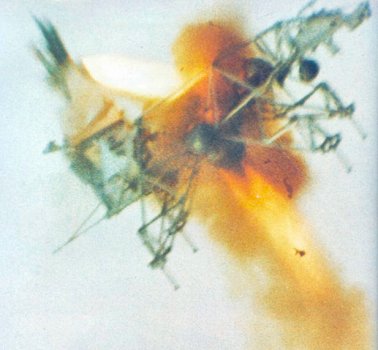RS Classics: What Do You Know About Accidents In Space?
>> Monday, June 7, 2010

As much as I, as someone that abhors loss of life for any reason, hates that the loss of life in our space exploration history, I am also fascinated. I need to know about these for my job, and, in fact, I would encourage anyone in the space industry to learn about them. A healthy understanding of what went wrong in the past is key to not repeating those errors. But, as much as I grieve for the lives lost, I am fascinated by the topic.
Part of my fascination is that there is so much information readily available and yet I was really amazingly ignorant of how many accidents there had been and how many near misses we’d had. Here I was, having worked in the space industry for eighteen years, and I saw an amazing presentation on this topic of accidents and near misses and escape systems at the last International Association for the Advancement of Space Safety (IAASS) Conference last year in Chicago. I wanted to know more. By a strange coincidence, I was in a position to investigate past accidents for a task not long afterwards.
Once again, Wikipedia came through for me with a article on “Space Accidents and Incidents”. I’d recommend anyone interested investigate this page and follow links. Remember, this includes not just US accidents, but accidents in space programs around the world, and a useful collection of near misses with many a useful lesson learned. Another excellent source of information on specific space missions is The Encyclopedia Astronautica (and, wow, they updated the look of it since I’d checked it out last in February).
Even though I’m recommending checking it out for yourself, I thought I’d tell you about a few that fascinated me:
Soyuz 1: The first flight of the craft that would be the workhorse of the Soviet/Russian human spaceflight program ended in tragedy when the parachute failed to open, killing Cosmonaut Vladimir Komarov.
Soyuz 11: The first Soviet flight to the first Soviet Station (Solyut), the successful mission ended in failure when they opened the hatch to a dead crew. A jolt during reentry caused a ventilation valve to fail open, causing depressurization. The crew recognized the depressurization, but could not close the valve before being overcome by hypoxia. Cosmonauts Dobrovolsky, Patsayev, Volkov were lost. The Soviets began flying a crew of two with pressure suits instead three crewmembers.
Gemini 8: A failed on rocket caused a spin that caused such G-forces that the crew was very close to blacking out before they regained control by shutting off the orbital attitude system and turning on the reentry system.
Soyuz 23: After an aborted docking with the Salyut 5 space station, an emergency landing put the crew of Soyuz 23, Cosmonauts Rozhdestvensky and Zudov, at risk as they landed in Lake Tengiz in -20 deg C conditions and during a blizzard. The capsule sank to the bottom of the lake and, because of conditions, could not be retrieved and opened until the next day. Amazingly, the crew emerged unscathed.
There were also a number of catastrophic launch and ground facility disasters including catastrophic fires at Baikonur Cosmodrome, Xichang, China and Alcantara, Brazil. Also, on that page, are notations of asphyxiation events on the ground at KSC, fires in oxygen chambers and training accidents.
Really, folks, this is fascinating stuff.




I've always been fascinated with disasters, a cool show that I don't think is on the air anymore was "Seconds from Disaster." It looked at all the problems leading up famous disasters.
Wow. I had no idea there were so many soyuz problems. Could it be that in the former Soviet union, we didn't hear about them?
Agree with Mother... thx for keeping us informed.
Well, damn, I meant to post this on Rocket Scientist. I'm a dummy.